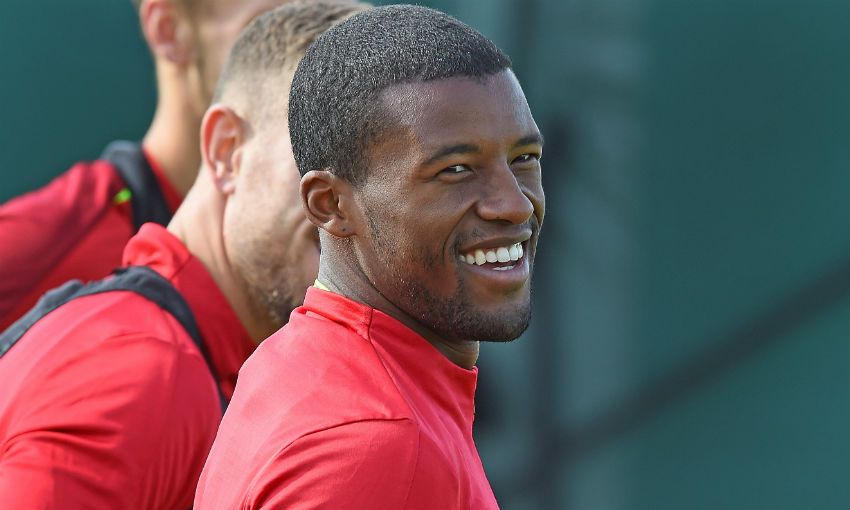Big interview | The making of Georginio Wijnaldum
“Always, always. I always knew.”
Georginio Wijnaldum’s belief never wavered.
Even as a child, even when he was told otherwise, even when some were skeptical, Wijnaldum was convinced.
He was, in fact, certain.
“People were trying to get me off thinking that I’m a midfielder, and trying to put in my head that I was a winger,” Wijnaldum remembers.
“There were loads of managers who said: ‘You have to concentrate on being a winger because you have more potential there.’
“But I was like: ‘You can say what you want, but I’m a midfielder and I know what’s the best for me.’
“So I just focused on midfield, and look where I am today. I was full of confidence in myself that I would reach the top or be a professional player as a midfielder.”
Today, Wijnaldum is a midfield mainstay for both club and country: an experienced 28-year-old who has passed the 50-cap mark for the Netherlands and is closing in on 450 senior club appearances - 108 of which have been for Liverpool.
It wasn’t always so, though; a fact that was eye-catchingly illustrated by Dutch newspaper AD recently.
A graphic entitled ‘Centipede Wijnaldum’ showed that, including his time at Sparta Rotterdam’s academy, he’s played pretty much everywhere, apart from in goal.
Recently, Liverpoolfc.com sat down with the Reds’ No.5 at Melwood to discuss a journey that eventually led to his desired destination, and how the circuitous route he took to get there helped shape the footballer he is now.
In his own words, this is the making of Georginio Wijnaldum…
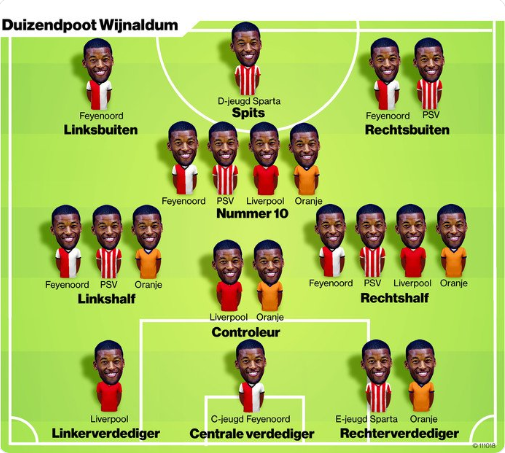
Sparta Rotterdam academy (1997-2004): Positions played - midfield, No.10, striker.
“When I played in the youth team I played a lot as a striker and as a No.10. There was one season, in what is called the U12s or U13s here, where I was only a striker and in the U14s I played as a striker also. I scored a lot of goals, but to be fair I didn’t really like that position because in my head I was more of a midfielder, even at that age. I felt better as a midfielder. Of course I enjoyed playing as a striker, but I enjoyed it more when I was playing as a midfielder, further back.”
Feyenoord (academy and first team, 2004-2011): Positions played - centre-back, midfield, right wing, left wing, No.10.
“When I started off at Feyenoord I was an attacking midfielder. They didn’t want me as a striker, more of a midfielder and I was happier with that because I had more joy playing there than as a striker.
“There were a few times I played off the left, but most of my games I played as a right winger. That’s something that went very well because I was young and I played a lot of games, but I didn’t enjoy it as much [as playing in midfield]. I enjoyed it, I enjoyed it everywhere that I played because as a football player you want to play a lot of times. It’s not a problem where but it was as a midfielder I had the most joy.
“In my whole youth [career] at Feyenoord I played as a midfielder, sometimes as a striker, sometimes as a central defender, but never really as a winger so I enjoyed it more to play as a midfielder than as a right winger. But to be honest, as a right winger I made my name because it went well, I showed my talent and everything, I scored goals as a right winger and I did it really good. It helped me a lot.”
Wijnaldum became Feyenoord’s youngest ever player when he made his first senior professional appearance at the age of 16 in April 2007.
“I made my debut and played in midfield as the No.10, but then Erwin Koeman left and [Bert] Van Marwijk came and he didn’t use me as a midfielder, he used me as a left winger. But I was still young and I still had to learn and everything, so I didn’t play a lot. I think I played, if you count everything together, probably [the equivalent of] five whole games.
“The year after [Gertjan] Verbeek came and I was still young, I was 17. He came and said to me that I would play more than the year before, that he had faith in me, but I have to wait on my chances. But because of all the injuries we had at Feyenoord at that time, I came in the team and came in as a right winger. It went well so he let me stay there! Sometimes I was playing as a No.10, but most of the time I was playing as a right winger.”

But why did coaches disagree with a youthful Wijnaldum’s assertion that he would be best deployed as a midfielder?
“Because I was dribbling a lot and they would say: ‘You’re walking too much with your head down, you don’t see everything on the pitch and if you play in midfield you have to see everything.’
“But as a youth I came to the first team as a midfielder and I did good. I was like: ‘Why don’t you try to help me fix it, instead of saying that’s your problem and it’s better for you to play as a winger?’
“Because I was a good midfielder and most of the time I think I was better than the players that already played there, but I think they were more mature so they didn’t lose the ball, they didn’t take risks where I was taking risks. I was young so it was safer to put me on the wing.”
However, change - for good, from Wijnaldum’s viewpoint - was afoot.
“When Verbeek got fired, Mario Been came. My first season under him I played as a right winger, and my second season I played as a left winger for half of the season then after the winter break, I came into the No.10 position.
“And to be fair, with Mario as my manager I was really lucky because he was a No.10 and what I didn’t have with a few managers before - helping me improve as a No.10 and a midfielder - I had it with him because he played in that position and he was my manager. I was really lucky at that time.
“I was 20 and had already played a lot of games because I started when I was 16 and when I was 17, I played almost every game for Feyenoord. So I was quite young but had three years where I was playing a lot of games, around 100 I think, if you count everything together.
“It went fast, but with Mario I had an unbelievably good relationship, he was my manager and was a man who also helped me a lot off the pitch with everything. He helped me a lot and I think because of him I did it better and I had the move to PSV as a No.10.”
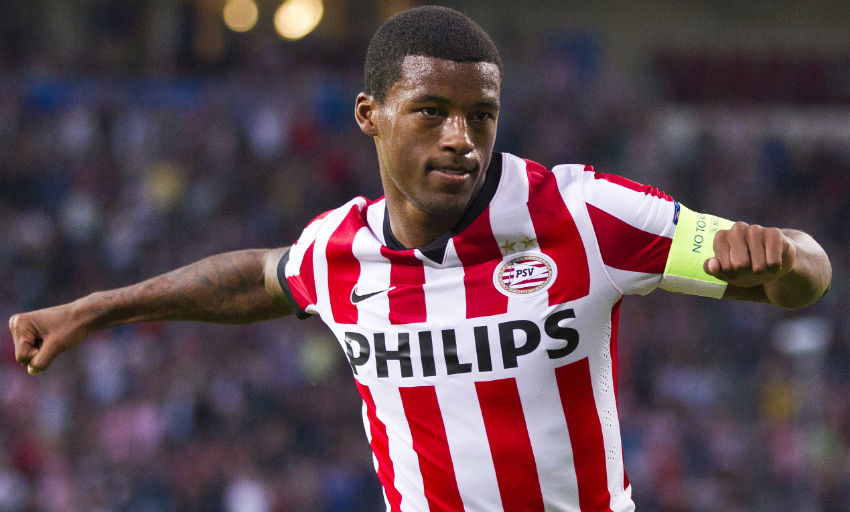
PSV Eindhoven (2011-2015): Positions played - No.6, right midfield, left midfield, No.10.
“In my first half-season with PSV I played more as a right midfielder, because we had a manager Fred Rutten who liked the way I was dribbling. I think he was one of the few people who liked it because everyone said ‘you have to play quick, you have to do that’.
“The problem nowadays is they say to players who can dribble that they have to play fast, instead of saying where they can dribble and when they have to use it and how they can use it the best. Rutten was a manager who was working with me on where and how I can dribble the best, and where I have to play simple. So he used the quality that I had and I think in that position with him, I played the best I’ve ever played.
“The way my dribbles came out and everything was really good. So basically while I wanted to play as a No.10 I played as a right midfielder, but it went quite well. Some games I was playing as the No.10, some games as the No.6, but it went really well.”
In a similar manner to Been at Feyenoord, Rutten afforded Wijnaldum coaching and advice that improved his understanding of how to operate as an elite-level midfielder.
“He was the kind of manager who instead of saying ‘no, you dribble too much’, he was more busy with: ‘Here you can use your quality the best, now you can use it the best, now you have to do this. In this position, when you’re standing here, I don’t think it’s safe to make a dribble - it’s better to pass simple because there is more space on the other side.’
“But a lot of trainers, they didn’t do that. They were like ‘no, it’s too risky for him to play on the right side’, but Rutten was really busy with other things.
“When he was busy with me, I understood the game better because I knew, or I was learning to do it, in places where it was effective. So that’s why I understood it more. You know, I’m still learning every day, but in that time I learned a lot because he showed me a lot on how to use my talent.”
Netherlands (2011-present): Positions played - No.6, right midfield, No.8, No.10.
Wijnaldum was reunited with Van Marwijk when his former Feyenoord boss handed him a full international debut at the age of 20 in September 2011, just a few months on from his move to PSV.
After initially coming into the Netherlands’ squad as an option at No.10, the transition to the deeper midfield roles Wijnaldum fulfils for Oranje today began in earnest under Louis van Gaal in the lead up to the 2014 World Cup - a tournament that represents a landmark in his career.
“I was injured for most of the 2013-14 season. I was out for seven months and I think it was only two-and-a-half months before the World Cup that I was fit again, so it was really difficult for me to go because I was not one of his first players, one of the starting players.
“I was a player who had just come to the national team again because when Van Marwijk left and Van Gaal came, he didn’t invite me for one year. I played for PSV as a midfielder again and he said he saw things he hadn’t seen before, because I was playing as a right-winger and he didn’t see me as a midfielder. He said to me ‘you have things I really like’, but it was more as an attacking midfielder.
“It was the beginning of the season and the first game I played under Van Gaal was against Portugal. I already had pain in my back but we didn’t know what it was, but then a few games later it was so bad that I couldn’t play.
“So I did rehab until the end of the season and I’d just come to the national team and went out for seven months, so I was not a player who was always in the squad, which made it a little bit difficult.
“But I was lucky that he gave me a chance to show myself that I could still be used in the World Cup. We had I think four weeks before the World Cup where we were in training camp with the players who were not playing abroad, where everyone could show what they could do, and I was unbelievably fit because I knew that if he gave me a chance, I have to be fit.
“I trained a lot at PSV. Even when I was fit I also played games with the second team to get fitter. Sometimes when the first team didn’t have a game at the weekend the second team had a game during the week so I would ask the manager [Phillip] Cocu if it was OK that I play with them because I needed minutes.
“It worked out. I think I had good sessions before the World Cup and when he picked the squad, I was in. A lot of people were like ‘how is it possible, he was injured, Van Gaal could’ve chosen this player or that player’. But he believed in me and he took me to the World Cup.”
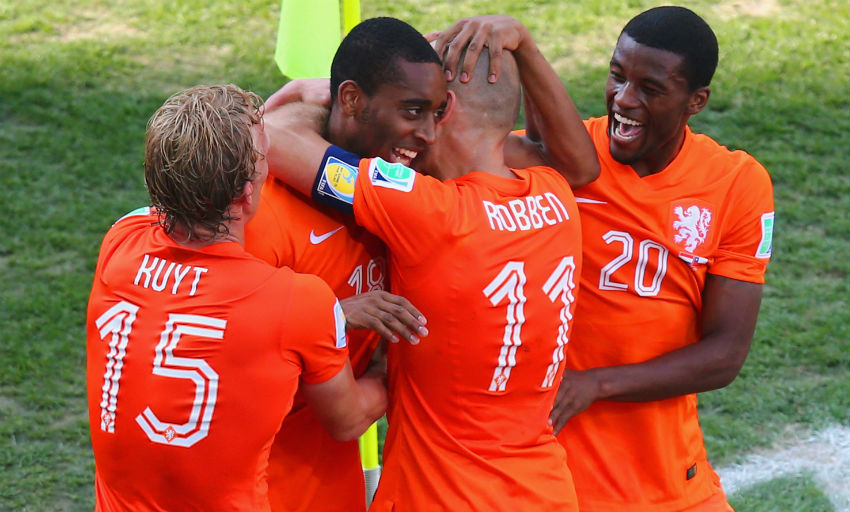
With the mission of forcing his way into Van Gaal’s 23 accomplished, once in Brazil Wijnaldum set about proving he was worthy of a place in the starting XI - with, it would transpire, the assistance of a legendary figure in Dutch football.
“To be fair in the first few sessions I thought I was only going to be there to help the team in training - Van Gaal was training with plan A, plan B, even plan C, and I was still on the bench! And when he changed tactics, I never came in the first XI.
“So I thought it was going to be a World Cup for me where I was sitting on the bench. But after the first game when we were 1-0 down to Spain then made it 1-1 and 2-1, I had to warm up after a few minutes and I saw Van Gaal speak with Danny Blind. He was looking back and said: ‘Gini, OK, you will come in.’
“I was surprised because we’d trained all the things and I was in none of them! But I was ready, I didn’t play for seven months and then I get the opportunity to go to Brazil and the World Cup. I came in and I did good. I had a chance to score but unfortunately missed against Spain, but in the second game I came on against Australia and did well again.

“Before the third game I had a meeting with Van Gaal and Danny Blind and Van Gaal said: ‘We’ve decided to let you play, but not as a No.10, as a right midfielder.’ He said he wasn’t sure if I could play that position, but Danny Blind said I could do it.
“From that moment, the third game in the group, [I played there] until the last game of the tournament in the third-fourth place play-off against Brazil, when I was a No.10 again. I scored against Brazil and that was my best game of the tournament, but I played good before that and a lot of people didn’t know that I could play in that position and do what I did in the World Cup. So it was an eye-opener for other people - but Danny Blind already knew!”
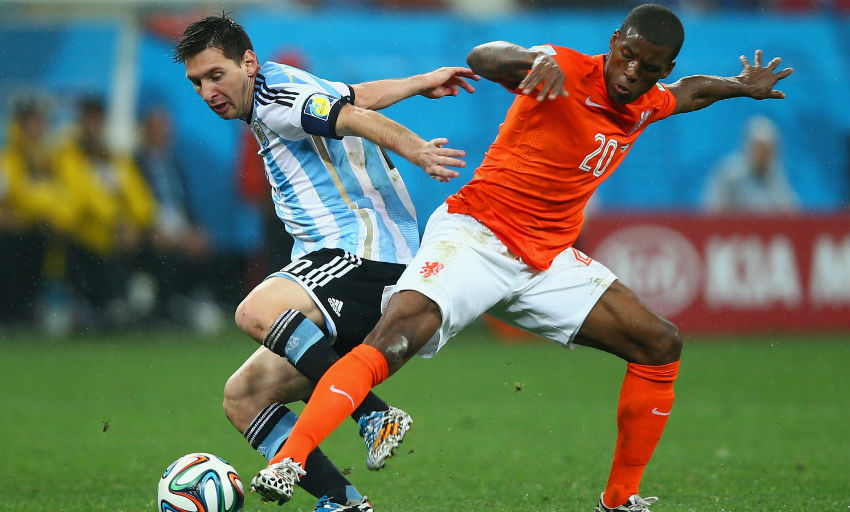
It was an eye-opener for Wijnaldum, too: a competition that unlocked the outer reaches of his potential.
“Playing at the World Cup gave me a lot of confidence and I improved a lot. When I went back to PSV and we played games it was so much easier than before because you learn so much in a World Cup. You train every day with good players and with good managers on the side, and you play against the best teams in the world, so it helped me improve a lot in my career and I saw it a lot when I went back to PSV.
“I don’t know if it was crucial for my career, but it helped me a lot. I saw it because I played before the World Cup and after the World Cup in the Eredivisie and I saw a big difference in how much easier it was for me to play.”
Newcastle United (2015-16): Positions played - No.6, No.8, right midfield, left midfield, left wing, No.10.
After a final season in his homeland, during which he captained PSV while playing in ‘attacking midfield, either on the left or right’, Wijnaldum transferred to Newcastle United.
“In the beginning I was playing as a No.10 for Newcastle and with Rafa Benitez I played a few games as a No.8 and a few as a No.6, and right midfield and left midfield. But a lot of games I also played as a left-winger because we were playing 4-4-2.”
Wijnaldum’s sole season at St James’ Park featured 11 goals in 40 appearances and a tactical education that is a by-product of working with Benitez.
“It was great playing for him, I learned a lot, a lot. When he came we collected a lot of points. He is really good at making a team with the type of players he has and he is also a man who knows how to get every bit of potential out of you. I was happy that he was there.
“I was devastated that Steve McClaren left because he brought me to Newcastle and he was great to work with and deserved way better from us as players, but I was also happy that I could work with Benitez.”
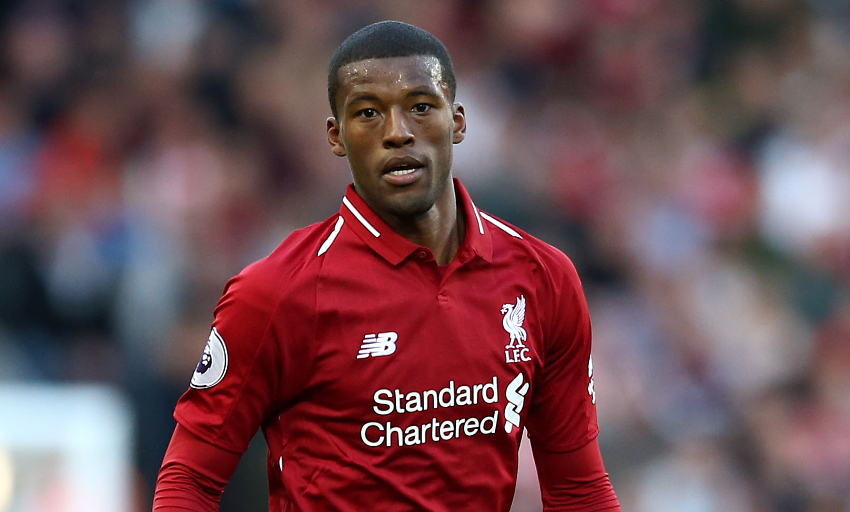
Liverpool (2016-present): Positions played - centre-back, No.6, No.8.
Then: Anfield.
“When I spoke to the manager here he said to me that we don’t really play with a No.10, that we play with two No.8s and that I would be one of the eights. But I think the manager got to know me way better during the first season. You train every day, you see each other every day. In the No.6 position we had Jordan Henderson and Emre Can and Kevin Stewart, so we had a few players there.
“But in my second season he said: ‘I think you can play No.6 also and we might use you there in some games, so be prepared.’ So during training I was playing there sometimes and during the pre-season games in Hong Kong I played there, but in actual games I only played there twice, against Manchester City and Everton I think. This season I’ve played there quite a lot and it’s gone quite well. I enjoy it.”
A defensive emergency led to Wijnaldum playing at the back for Liverpool for the first - and, he hopes, last - time in a 5-1 win over Brighton and Hove Albion in December 2017.
“That was interesting, but it was really difficult! I had played as a central defender before but more with two. In youth football we played with a three but one was further forward, in front of their striker, so basically as an extra midfielder. So I played there but not really as a central, central defender.
“But this time I was like a central, central defender so it was difficult! Emre was there too so there was two of us, but I struggled a little bit and when I looked over the other side I saw Emre doing it so good! Emre did it quite well there, and I was struggling - especially in the first half, because I’d never played with three, always with four and I was basically an extra midfielder then. It was interesting - and quite funny.”

Centre-back, No.6, No.8, right midfield, left midfield, right wing, left wing, No.10 and striker.
So, how has playing in so many positions over the years aided the development of the modern-day Wijnaldum, the established midfield presence for Liverpool and the Netherlands?
“It helps you understand the game because you see the game from different positions. Basically you can think for more players and you can help more players because you understand what they are going through.
“It helps me a lot also because I’ve played a lot of games because I can play in different positions. But on the other side it was also my weakness, because if a manager has two players who can play as a No.10, but one can play as a winger, you will always move for the other one. So it was my strength, but also my weakness.
“It was the best for the long run that I played in different positions, but sometimes I also think that I wanted to develop as a midfielder so I could maybe be even better now.
“You never know how it would be, but maybe if you play more games when you are younger you will be even better, you would have more experience and everything. So a lot of times I was like: ‘Just let me play in the midfield and just play who you think is the best there.’
“I wanted to play as a midfielder so bad, but when I look back I’m happy that I played in those positions because now I know how it is to play there. I’ve played a lot of games and I think you can help the team better.
“But I’m a midfielder now. That’s good.”


